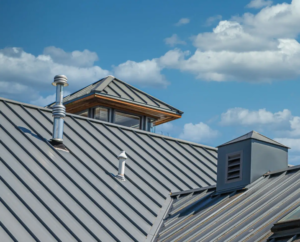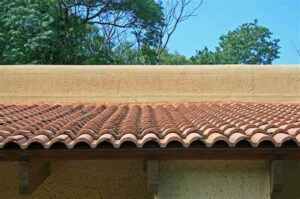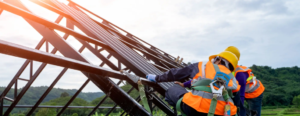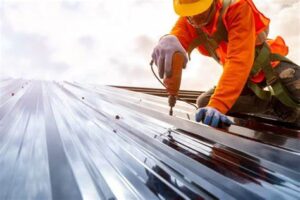Looking to give your home a significant upgrade with a new roofing solution? Installing metal roofing over shingles might just be the game-changer you need. This approach has been gaining popularity among homeowners for its durability, energy efficiency, and environmental benefits.
Metal roofs can withstand severe weather conditions better than traditional shingles, promising fewer roofing repairs and replacements over time. Plus, they reflect solar heat, keeping your home cooler and reducing energy costs. Installing metal roofing over existing shingles also means less waste in landfills, making it a greener choice.
This method is quicker and less disruptive, saving you time and money. If you’re considering a durable, cost-effective, and eco-friendly roofing solution, diving into the world of metal roofing over shingles could be the best decision for your home. Let’s explore the benefits, prerequisites, and steps involved in making this upgrade a reality.
Why Install Metal Roofing Over Shingles?

Installing metal roofing over shingles has become an increasingly popular choice for homeowners looking to upgrade their roofing systems. This method offers a multitude of benefits, making it a practical and efficient solution for enhancing home protection and aesthetics. The primary advantage of opting for metal roofing over shingles lies in its durability and longevity.
Metal roofs are known for their ability to withstand severe weather conditions, including high winds, heavy rain, and snow, significantly outlasting traditional shingle roofs. This resilience translates into fewer roofing repairs and replacements over time, making metal roofing a cost-effective investment in the long run. Another compelling reason to consider this roofing option is its energy efficiency.
Metal roofs reflect solar radiant heat instead of absorbing it, which can lead to considerable savings on cooling costs during warmer months. This feature not only reduces energy consumption but also contributes to a more comfortable living environment inside the home. Moreover, installing metal roofing over existing shingles is an environmentally friendly choice.
It eliminates the need for shingle disposal in landfills, as the metal roofing can be installed directly on top of the old shingles, provided the structure can support the additional weight. This approach also reduces waste and the environmental impact associated with roofing materials. The installation process itself offers advantages, as it can be quicker and less disruptive than removing the old shingles before installing a new roof.
This can save homeowners time and labor costs, making the transition to a metal roof smoother and more cost-efficient. In summary, opting to install metal roofing over shingles is a wise decision for homeowners seeking a durable, energy-efficient, and environmentally friendly roofing solution. Its ability to offer long-term protection and cost savings, coupled with its aesthetic appeal, makes it an excellent choice for enhancing the value and function of any home.
Cost-effective over Long Term
Opting for metal roofing over shingles is a cost-effective choice over the long term. Although the initial investment may be higher compared to traditional roofing materials, the unparalleled longevity of metal roofs reduces the need for frequent repairs and replacements. Their robustness and resilience against wear and tear ensure homeowners can enjoy decades of protection without incurring costly maintenance.
This durability leads to substantial savings over the roof’s lifespan, making metal roofing a wise financial decision for the future.
Related: How Much Does Roofing and SidingCost?
Enhances Durability Against Elements
Metal roofing is renowned for its exceptional durability against various weather conditions. Designed to withstand high winds, heavy rainfall, snow, and even hail, metal roofs offer a superior level of protection compared to traditional shingles. This resilience is vital for maintaining the home’s structural integrity and safeguarding it from the elements.
By choosing to install metal roofing over shingles, homeowners can significantly boost the durability of their roofing system, ensuring it remains intact and functional through even the harshest weather scenarios.
Improves Home Energy Efficiency
Among the key benefits of metal roofing is its capacity to significantly improve home energy efficiency. Unlike traditional materials, metal roofs reflect solar radiant heat instead of absorbing it, which can lead to a noticeable decrease in cooling costs during warmer months. This reflective capability not only results in lower energy bills but also promotes a more comfortable and consistent indoor climate.
By opting for metal roofing, homeowners can make a meaningful impact on their home’s energy consumption, aligning with both economic savings and environmental sustainability.
What are the Prerequisites?
Before embarking on the installation of metal roofing over shingles, it’s crucial to ensure all necessary prerequisites are met to guarantee the project’s success and compliance. The first step involves conducting a thorough roof inspection to assess the existing shingles and the overall structural integrity of the roof. This inspection is vital for identifying any areas that require repair or reinforcement prior to the metal roofing installation.
Additionally, checking local building codes is an essential step. Different regions may have specific regulations or restrictions when it comes to installing metal roofing over shingles. Ensuring compliance with these codes is crucial not only for the legality of the installation but also for maintaining the safety and integrity of the roofing system.
Meeting these prerequisites is fundamental in laying the groundwork for a successful metal roofing installation, ensuring that the project adheres to safety standards and local building regulations, and ultimately, securing the longevity and effectiveness of your new roof.
Conduct Thorough Roof Inspection
Conducting a comprehensive roof inspection is paramount prior to installing metal roofing over existing shingles. This crucial step involves a detailed evaluation of the shingles’ current state and the roof’s overall structural health. Inspectors look for damaged areas, such as cracked, missing, or curled shingles, and assess the underlying roof deck for signs of deterioration or instability.
Addressing these issues is essential to ensure that the roof is capable of supporting the weight and structure of the new metal roofing. By identifying and rectifying any potential problems early on, homeowners can lay a solid foundation for their metal roofing installation, safeguarding against future issues.
Check Local Building Codes for Compliance
Ensuring compliance with local building codes is a critical prerequisite for the installation of metal roofing over shingles. Since building codes and regulations can significantly vary across different jurisdictions, it’s essential for homeowners to familiarize themselves with the specific requirements of their area. This includes obtaining all necessary permits and ensuring that the roofing project conforms to local standards.
Adhering to these regulations not only secures legal compliance but also ensures that the installation meets safety and quality standards, providing peace of mind and protection for both the structure and its inhabitants.
How to Prepare the Shingle Roof?

Preparing the shingle roof for a metal roofing installation is a critical process that involves several key steps to ensure a successful and enduring outcome. Initially, it’s important to repair or replace damaged shingles to create a stable and even surface. This preparation is crucial for preventing potential issues under the new metal roofing.
Ensuring the roof structure’s soundness is another essential step; the structure must be capable of supporting the weight of the metal roofing without any risk of collapse or significant wear over time. Finally, installing synthetic roofing underlayment provides an additional layer of protection against moisture, significantly enhancing the roof’s overall longevity and performance. These preparatory actions are vital for a seamless and efficient transition to metal roofing, safeguarding the structural integrity of the building and optimizing the functionality of the new roof.
Repair or Replace Damaged Shingles
Repairing or replacing damaged shingles is a critical first step before the metal roofing installation. This ensures a smooth and stable surface, crucial for preventing potential installation issues and enhancing the metal roof’s longevity. Addressing these damages not only helps in preventing moisture penetration but also safeguards the underlying roof structure from further deterioration.
Ensure Roof Structure is Sound
Verifying the roof structure’s soundness is essential. A comprehensive assessment must be conducted to ensure the roof can support the additional weight of the metal roofing. This includes checking for any signs of sagging, rot, or structural damage.
Ensuring the roof’s structural integrity is paramount for a safe and effective metal roofing installation.
Install Synthetic Roofing Underlayment for Extra Protection
Installing synthetic roofing underlayment offers an additional layer of moisture protection. This underlayment serves as a secondary barrier, significantly enhancing the roof’s defense against water intrusion and leaks. Its installation is a crucial preparatory step, providing the foundation for a durable, weather-resistant metal roofing system.
What Materials are Needed for Metal Roofing Replacement?
For a successful transition to metal roofing over shingles, the selection of the right materials is essential. Metal panels or interlocking shingles serve as the primary coverage layer, offering both durability and aesthetic appeal. To ensure enhanced moisture protection, high-quality synthetic underlayment acts as a critical barrier, lying beneath the metal surface to safeguard against water intrusion.
Flashing for edges and valleys is indispensable, designed to direct water away from the roof’s most vulnerable areas and prevent leaks. Additionally, appropriate fasteners are required to securely attach the metal panels or shingles to the wooden structure of the roof. These fasteners must be chosen carefully to avoid corrosion, ensuring a secure and long-lasting installation.
Together, these materials form the backbone of a robust, weather-resistant metal roofing system, combining to offer superior protection and longevity.
Metal Panels or Interlocking Shingles
Metal panels or interlocking shingles form the critical outer layer of the roofing system. Designed for both durability and visual appeal, these materials are key to a roof that can withstand harsh weather while enhancing the home’s exterior.
High-quality Synthetic Underlayment
A layer of high-quality synthetic underlayment is crucial for water resistance beneath the metal surface. This underlayment acts as an additional barrier, safeguarding the roof against moisture and ensuring its long-term durability.
Flashing for Edges and Valleys
Flashing for edges and valleys is indispensable for water management on the roof. Proper installation ensures that water is effectively directed away from vulnerable areas, preventing leaks and protecting the structure from water damage.
Appropriate Fasteners for metal-to-wood attachment
Choosing the right fasteners is essential for the secure attachment of metal panels or shingles to the wooden structure of the roof. These fasteners must be specifically suited for metal-to-wood connections to prevent corrosion and ensure a stable, long-lasting installation.
Related: What are the Best Roofing Materials?
Step-by-step Guide to Metal Roofing Installation

The installation of metal roofing over shingles involves a sequential and meticulous approach to ensure the roof’s effectiveness and longevity. The process begins with accurately measuring the roof area, a critical step for determining the exact quantity of materials required. Following this, cutting metal panels to precise dimensions ensures a perfect fit on the roof.
Next, the installation of a drip edge along the roof’s perimeters is essential for effective water management, preventing water from seeping under the metal panels. Securing synthetic underlayment across the entire roof acts as an additional moisture barrier, enhancing the roof’s protection against water intrusion. The core of the installation process involves starting panel installation from the bottom up, with careful attention to correct panel overlap according to type, crucial for leak prevention.
Fastening each panel at designated points is necessary for a secure attachment to the roof structure, ensuring stability and durability. Finally, applying flashing around chimneys, vents, and valleys addresses potential water penetration in vulnerable areas, completing the installation process. This step-by-step guide is designed to facilitate a thorough and precise metal roofing installation, resulting in a durable, weather-resistant roofing system.
Measure Roof Area Accurately
Accurately measuring the roof area is the first critical step, ensuring that you have the correct quantity of materials. This precision minimizes waste and optimizes resource use during the metal roofing installation.
Cut Metal Panels to Exact Dimensions
Cutting metal panels to exact dimensions guarantees a perfect fit on the roof. This precision is essential for correctly aligning panels and ensuring comprehensive coverage and maximum protection.
Install Drip Edge Along Roof Perimeters
Installing a drip edge along the roof perimeters plays a key role in effective water management. This element is designed to channel water away from the roof, safeguarding the structure from potential water damage.
Roll Out and Secure Underlayment Across Entire Roof
Rolling out and securing underlayment across the entire roof acts as a crucial moisture barrier. This additional layer significantly enhances the roof’s resistance to water, providing an essential safeguard against moisture intrusion.
Start Panel Installation from the Bottom Up
Initiating panel installation from the bottom up is a strategic approach that ensures correct panel alignment and optimal overlap, which are vital for a leak-proof roofing system. This methodical technique is foundational to the integrity of the metal roof installation.
Overlap Panels Correctly According to Type
Correctly overlapping panels according to their type are vital for maintaining the roofing system’s seal against the elements. Proper overlap is a critical defense mechanism against leaks, ensuring the roof’s long-term resilience and effectiveness.
Secure Each Panel with Fasteners at Designated Points
Securing each panel with fasteners at designated points ensures a robust and secure attachment to the roof’s structural framework. This step is indispensable for the durability and performance of the metal roofing system over time.
Apply Flashing Around Chimneys, Vents, and Valleys
Applying flashing around chimneys, vents, and valleys is essential for addressing the roof’s most vulnerable points. Properly installed flashing directs water away from these areas, preventing leaks and preserving the integrity of the roof’s structure.
Read more: How to Install Metal Roofing?
Common Mistakes to Avoid

Avoiding common mistakes is crucial for the longevity and effectiveness of the metal roofing system. One significant error is the use of incompatible fasteners, which can lead to corrosion and undermine the roof’s structural integrity. Another issue is an inadequate overlap of metal panels, potentially resulting in leaks that compromise the roof’s ability to resist water.
Additionally, neglecting the proper installation of flashing around critical roof features such as chimneys, vents, and valleys can lead to water penetration and subsequent damage. Being vigilant about these common pitfalls and taking proactive steps to avoid them is essential for ensuring a durable, leak-proof metal roofing installation.
Using Incompatible Fasteners Causing Corrosion
Choosing compatible fasteners is essential to prevent corrosion. Using the wrong type can severely compromise the roof’s structural integrity by causing rust. It’s crucial to select fasteners that are specifically designed for use with metal roofing to ensure a secure and lasting installation.
Inadequate Overlap Leading to Leaks
Adequate overlap of metal panels is critical to avoid water intrusion. Failure to properly overlap panels can result in leaks, undermining the roof’s protective capabilities and potentially causing damage to the interior structure. Precise installation techniques are necessary to maintain the roof’s integrity and weather resistance.
Neglecting Proper Flashing Installation Around Roof Features
Proper installation of flashing around chimneys, vents, and valleys is indispensable for preventing water penetration. Overlooking this critical step can lead to significant leaks and subsequent damage. Correctly installed flashing acts as a barrier, directing water away from vulnerable areas and ensuring the roof’s overall effectiveness against moisture.
Maintenance Post-Installation
Post-installation maintenance is essential to ensure the longevity and optimal performance of a metal roofing system. Conducting semi-annual inspections is key to identifying and addressing potential issues early, such as rust or sealant failure. Regular cleaning of gutters and the roof surface is crucial to prevent the accumulation of debris, which ensures water can freely flow away from the roof, reducing the risk of water damage.
Additionally, monitoring for signs of rust or sealant failure is vital for maintaining the roof’s structural integrity and water resistance. By adhering to these maintenance practices, homeowners can ensure their metal roofs remain in excellent condition, offering reliable protection for years to come.
Conduct Semi-Annual Roof Inspections
Semi-annual roof inspections are essential for the early detection of any potential issues. Regular checks allow for the identification and prompt repair of minor problems, safeguarding the roof’s longevity and optimal performance.
Keep Gutters and Roof Surface Clean of Debris
Regular maintenance to keep gutters and the roof surface clean of debris is crucial for preventing water buildup and subsequent damage. Clearing away leaves, branches, and other debris ensures that water can freely flow off the roof, reducing the risk of leaks and water damage.
Monitor for Signs of Rust or Sealant Failure
Monitoring for signs of rust or sealant failure plays a key role in maintaining the roof’s structural integrity. Early identification and correction of these issues help prevent moisture infiltration, preserving the roof’s condition and extending its service life.
Get Professional Help from Us
For homeowners contemplating the switch to metal roofing or in need of maintenance for their current system, seeking professional assistance is key. Our team specializes in metal roofing installation and maintenance, ensuring that every aspect of your project is handled with expertise and attention to detail. From the initial roof inspection and choosing the right materials to the meticulous installation process and ongoing maintenance, our professionals are with you every step of the way.
Opting for professional help not only guarantees the durability and efficiency of your metal roof but also offers the peace of mind that comes from knowing your home is protected by experienced hands. Contact us today to get started and claim a FREE estimate!
Final Thoughts
In wrapping up, the decision to opt for metal roofing, or to maintain an existing metal system, demands thoughtful consideration and meticulous planning. The benefits of metal roofing, such as its durability, energy efficiency, and long-term cost-effectiveness, position it as a valuable investment for homeowners. Adhering to a systematic installation approach, steering clear of common errors, and dedicating oneself to ongoing maintenance can greatly enhance the lifespan and functionality of a metal roof.
Engaging professional help ensures precision in every phase of the process, providing your home with optimal protection and maximizing your investment. Ultimately, a well-implemented and maintained metal roof delivers unmatched protection and value, standing out as an exemplary choice for any residence.
